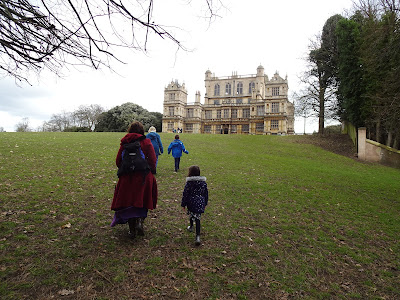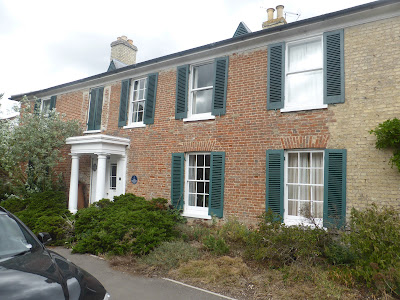My photograph of Oliver Cromwell's house in Ely
(See Part I here and Part II here)
Historians of the Seventeenth century will know that Oliver Cromwell's house, the one in which he lived and worked between 1636 and 1647, is within an arrow's flight of the huge monument to medieval Catholicism that is Ely cathedral. Cromwell in many ways stood for everything that Ely Cathedral was not. The puritan Celia Fiennes was typical of Cromwell's puritanical strain of thought:
When Celia Fiennes recorded her visit to Ely in 1698, she could remark, "this church has the most popish remains in its walls as any I have seen" (Ely Cathedral guide page 20)
As a mere dabbler in history I have to confess that I didn't know that Cromwell's house was so close to the Cathedral until I visited Ely in the warm September of 2020! But coming to this fact for the first time in my life meant that I was blown away by the surprising and hugely ironic juxtapositions of these two buildings, both monuments to two very disparate expressions of the faith. Cromwell so epitomized the austerity, the business-like practicality and lack of finesse & decorum that goes together with the resurgence of middle-class puritanical devotion of that day. According to the Cathedral guide:
The puritans rejected all but the plainest forms of worship - in a letter to the Precentor, Cromwell described the choir service as "so unedifying and offensive" - and during the Commonwealth, Ely ceased to function as a Cathedral.
Cromwell's reaction to the Cathedral and its form of devotion is nothing but what you'd expect from him.
Progressively, Cromwell had moved into a popularist position where he had gained the influence and authority to implement his brand of idealism:
Oliver who had undergone a religious conversion in his late twenties believed himself to be one of God's Chosen People or Elect. He was fiercely critical of High Churchmen, like Matthew Wren, Bishop of Ely and of authority generally, defending the rights of the fenmen against those who sought to drain their land without adequate compensation. The popularity and support that he won from those whose cause he defended earned him the name "Lord of the Fens". In 1640 Cromwell was elected MP for Cambridge and so became increasingly involved in national affairs. (Guide to Cromwell's House page 2)
Here we see the beginnings of that common political phenomenon where a popularist rebel against established authority (who may otherwise have a just cause) eventually maneuvers themselves into a position of established authority without any sense of irony. In fact after the 1642 civil war Cromwell became an absolute authority:
During the disturbances of the Civil War in January 1644 Cromwell warned Mr Hitch, the Precentor of the Cathedral "Lest the souldiers in any tumultuary or disorderly way attempt the Reformation of the Cathedral Church, I require you to forbear altogether your choir service, so unedifying and offensive....". Hitch ignored the warning so Cromwell saying that he was "a man under authority" ordered him to "leave off your fooling and come down"; Cromwell then drove out the congregation. In 1649 Parliament ordered an inquiry into the possible demolition of the Cathedral, which was in a decayed state, so that the sale of the materials might be applied to "the relief of the sick and maimed soldiers, widows and orphans". The Cathedral survived only because the cost of demolition was estimated as greater in the value of the materials remaining. but was almost certainly closed for about seventeen years. (Guide to Cromwell's house page 5)
The take home lesson here (as if we didn't know already), is that fundamentalists and idealists have no mercy if it cuts across their ideology; ideology first, grace second, if at all. The architectural wonder of Ely Cathedral only survived because practicalities made it too expensive to demolish! (Let's recall how ruthless the Taliban and Islamic state were toward the heritage of the past). Notice also the time honoured tension between the cost of the monumental and the cost of servicing the less fortunate.
For me Cromwell is a frustrating figure who missed his opportunities for true reform because of his uncompromising idealism; his obsessive anti-Catholic ideals drove an unbending sometimes merciless agenda. It is axiomatic to idealists and fundamentalists of Cromwell's ilk that critics are assumed to have hidden and malign motives for disagreeing and therefore justifiably dealt with by coercion. Cromwell's self-belief meant that he could see no irony in his wielding absolute authority and in his willingness to use the threat of lethal force, a threat which he excused with the euphemism of "being under authority". He used that threat to drive out Ely's congregation and later squabbling parliamentarians. He became head of a joyless dictatorship that was consequently all too open to a reactionary return to the very things he opposed. But in spite of all that I believe Cromwell had the right idea at least in a theoretical sense; that is, of a parliamentary forum for the common people; but for him only those common people of sufficiently puritanical frame of mind, else he was liable to exercise his "authority". Like idealists the world over Cromwell didn't see that as a sinner he was as much part of the problem as the solution. If he had seen that he might have understood that there is little choice but to work with a morally and epistemically compromised humanity. He might have also understood that a squabbling often corrupt parliament with a tendency toward selfishness was, as Walpole observed, the natural state of human affairs and must be wisely managed & regulated rather than engaged in a futile struggle to eradicate sin - only God can do that.
But then the mitigation for Cromwell was that this was early days in the democratic experiment and I suppose a lack of understanding of what real democracy actually looks like in all its messy compromised & argumentative untidiness would have been beyond an idealist who faced the conundrum of all idealists: That is, as the French revolutionaries discovered, the full implementation of an ideology can only be achieved under totalitarian conditions; the very thing many idealists see themselves as rebelling against. Underneath it, however, I believe Cromwell was not motivated by a desire to seek power and he refused the crown. He genuinely wanted power to be in the hands of the commoners, but at that stage in British history he really had no idea how to implement his vision among sinners and his fall back was his own sense of being right and his willingness to use diktat. That a noisy contention is a necessary concomitant of true democracy just seemed wrong, wrong, wrong to a buttoned up puritan. I'm tempted to accuse him of being a block-head, but I'll refrain; it's easy to criticize Cromwell in hindsight.
***
Move on 200 years into another age, the 19th century, and we find the romance of the gothic revival in full swing. The attitude profile had changed; at least in some quarters. The gothic purists found the abuse of the fabric of Ely Cathedral as equally offensive as Cromwell found the Cathedral services of his day: According the the Cathedral guide:
The architect and chief protagonist of the Gothic revival in England, A. W. N. Pugin, on walking into the Lady Chapel, is said to have burst into tears exclaiming, "O God, what has England done to deserve this".
The Cathedral underwent restoration in the early Victorian period. These post-enlightenment people who were now well into the age of the mechanical, the industrial and the intellectual had acquired a taste for the mysticism of ritual and symbol. Ely Cathedral as a suitably atmospheric & monumental venue serving these tastes suited them down to the ground.
***
In Mat 7:13-14 we read:
“Enter through the narrow gate. For wide is the gate and broad is the road that leads to destruction, and many enter through it. But small is the gate and narrow the road that leads to life, and only a few find it."
The ways to destruction are many, the ways to life very few; (that sounds like a consequence of disorder theory to my ears!). I would question whether sinners ever find that gate at all; rather it is found for them and revealed to them by a God of Grace.
The path of human salvation goes through the narrow gate of the Cross, but the path to ultimate salvation (as Bunyan discovered) is a winding way, perhaps even a maze, as the complexities of Christian history testifies. Let me finish this post with these words taken from the Ely Cathedral guide as it comments on one of the millennium sculptures found in the Cathedral:
Adjacent to the labyrinth and complimenting its symbolism, is Jonathan Clarke's The way of Life [sculpture]. It is cast in aluminium with nine sections, each differently jointed. Like the journey of life, its path in irregular and unpredictable and as the journey is sometimes hard, sometimes joyful, so the surface texture and the colour also vary. Perhaps to give a human scale to the journey Jonathan Clarke placed a tiny human figure on the top arm of the cross. (See below)
To me it's also a metaphor for the journey of Christian history itself with its motely mix of heroes, sharp minds, successes, reverses, eccentrics, extremists, fundamentalists, cultists and woolly thinkers (They know who they are!)
Clarke's Way of Life sculpture
I'd call this the Maze of Life, with its dead-ends, opportunities, surprises and openings.






































